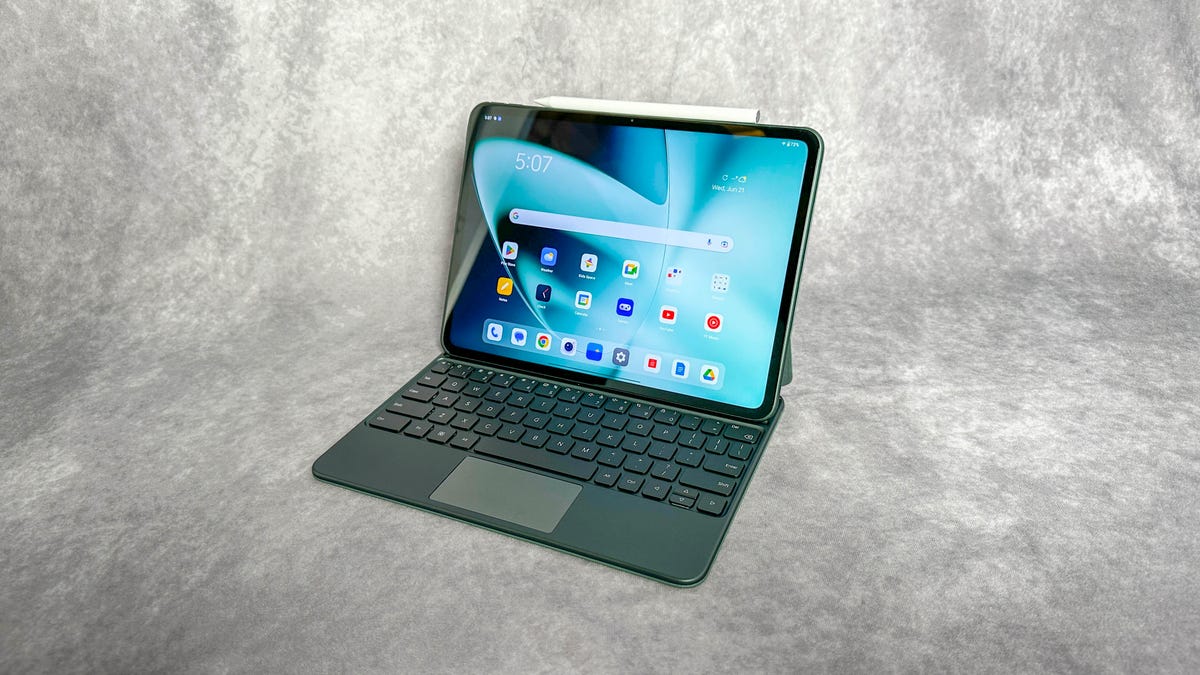
Android tablets have had a chaotic life story. While the iPad has maintained a steady dominant path since 2010, I’ve seen Android tablets come and go. Samsung has steadily made good ones; Google has returned focus to them again with the Pixel Tablet. Then there are more budget-friendly options from Amazon and Lenovo. And now OnePlus has its own midrange option, the OnePlus Pad, that’s also worth considering. The good news is that about $500 can get you some good options right now if you want a tablet that runs Android apps. The unclear news is how well Android OS and Android apps will keep adapting to make these tablets everything we want them to be.
If you’ve been following Samsung’s Galaxy Tab designs, OnePlus is taking a similar path with its Pad but at a lower price. The OnePlus Pad feels premium enough to get all your everyday basic tablet needs done, and it has accessories to make it feel like a sort-of laptop, much like an iPad. But, as a device that’s still spiritually separated from Google’s new home-focused Pixel Tablet, it runs a variant type of Android OS. I want the tablet where OnePlus Pad meets Pixel Tablet, mixing the best of both. It’s close. But right now the Android tablet landscape makes you choose your purpose.
I’m writing my OnePlus Pad review on the OnePlus Pad, because it has its own optional keyboard case with a trackpad. This, and a stylus, make it a tablet worth considering if you’re mostly into the idea of working on big-screen apps on the go with work accessories.
Sorry, I’m a big fan of this keyboard.
Google’s Pixel Tablet, on the other hand, has evolved with a smoother software interface that works more intuitively for split-screen multitasking — though the OnePlus Pad has split-screen support as well — and the Pixel has a speaker dock that also turns it into a better casual home option if you prefer that road versus a personal keyboard-equipped tablet.
I prefer the Pixel Tablet’s design but the OnePlus Pad’s accessory set. I think you’d likely be satisfied with either one for the price, but with the OnePlus Pad, you have to consider the cost of the upgrades: The keyboard case is an extra $150, while the magnetically attaching stylus is $99. That makes the total OnePlus Pad package I’d want to use $727, which is expensive. (If you buy the keyboard case and stylus at the same time as the Pad, however, OnePlus discounts the accessories 50%, lowering the total cost to $605.) Samsung’s more-expensive S-series tablets at least come with the S-pen stylus in the package.
No fingerprint sensor, but face unlock
I’m not wild that the OnePlus Pad uses face unlock instead of a fingerprint sensor, because I still wear a mask a lot, and this tablet doesn’t recognize my masked face at all. I like the Pixel Tablet’s security chip and fingerprint system more.
Multitasking on this big 11.6-inch screen is easy.
Display: Big and high-res
The 11.6-inch display and its 2,000×2,800-pixel resolution looks pretty great for full-screen web browsing, watching movies and working on documents. It’s also more than big enough for split-screen, two-app multitasking.
Design: Pleasingly compact
The thin aluminum frame and relatively small bezel make it feel pretty portable, too. OnePlus’ separately sold magnetic keyboard case is also nicely slim and makes the whole package slip easily into a small bag, while still being lap-friendly. It’s basically the tablet-keyboard-case design and feel I’d want… and strangely, that Apple hasn’t made happen with its various iPad keyboard cases.
But: Why is the tablet gunmetal green? And the rear camera, with its surprisingly large center bump, weirdly protrudes unless you have a case to absorb its bulge. The smooth, rounded edges are comforting, and I prefer them to sharp edges.
The rounded edges and aluminum build feel great (except, why this color green?).
OS: Kind of weird?
OnePlus’ version of Android 13, called OxygenOS, enables multitasking, swiping and other navigation shortcuts that should feel familiar to phone and iPad owners. And yet, it’s kind of weird. Accessing multitasking panes for apps requires pressing small buttons and swiping up. Also, for some reason, OnePlus skips using an app dock as the way to drag apps into multitasking panes, even though that’s the default logical interface on the Google Pixel Tablet and iPad.
Before Google’s Pixel Tablet, maybe I could understand OnePlus wanting to go its own way on an interface language. But I wish now that the tablet would just adopt the Pixel Tablet’s more intuitive (to me) gesture shortcuts.
OxygenOS isn’t bad, and it works. But it’s just… weird.
It’s worth getting the keyboard case for this one… just budget it in.
For a nice Android tablet with a good keyboard, Pad is a safe bet
I still prefer the Google Pixel Tablet as a sharable home device, but the OnePlus Pad won over my “personal tablet” side. The big, rich display, solid accessories and good performance of this tablet would make me happy, if I were to pick an Android tablet. It feels premium, even despite its lower price. That being said, I don’t think the Android tablet landscape is totally solidified or perfected right now. But in 2023, for its price, this is one of your best bets.
